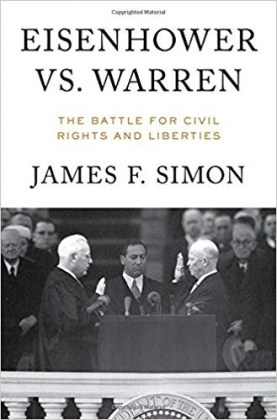In the News
News
Jan 03, 2019
BOOK REVIEW
Eisenhower vs. Warren: The Battle for Civil Rights and Liberties
Jan 03, 2019
By Charles Dresow

James F. Simon’s, “Eisenhower vs. Warren: The Battle for Civil Rights and Liberties,” is a compelling study of the relationship between a president and chief justice at a critical time in the history of civil rights. Given today’s tense atmosphere between the judiciary and the chief executive, the book is especially timely. Mr. Simon begins with a summary of the often forgotten fact that Chief Justice Earl Warren had a long and influential career in California prior to President Eisenhower appointing him to the United States Supreme Court. Among other accomplishments, he was the District Attorney of Alameda County, the Attorney General of California, and eventually Governor of California during World War II. Although the book primarily focuses on Warren’s relationship with Eisenhower, it is worth pondering that the man who authored the Brown v. Board of Education opinion which led to the legal desegregation of our society also was a wholehearted supporter of the internment of Japanese Americans during World War II. Simon briefly discusses Warren’s support for internment but the primary focus of the book is on Brown and Eisenhower and Warren’s disagreements over it.
Eisenhower’s pre-presidential history is much better remembered than Warren’s earlier years. As a general, Eisenhower commanded the allied forces who liberated Europe during World War II. He was known as a consensus builder who was able to hold together a coalition of allies in the liberation of Europe and effectively manage some of the very difficult personalities who served under him. As President, Eisenhower’s directives were critical in the final steps of the desegregation of the military and other federal programs. As President of Columbia University after World War II, Eisenhower staunchly supported academic freedom and opposed faculty loyalty oaths.
Simon uses the loyalty oath controversy to paint the first contrast between Eisenhower and Warren. In the late 1940s and early 1950s at the height of the anti-communist Red Scare movement, Senator Joseph McCarthy led a movement to have professors at colleges take a “loyalty oath,” in which they would profess that they were not communists and did not support communism or the overthrow of the United States Government. Professors faced termination if they refused. Eisenhower was an outspoken advocate of academic freedom and went on record opposing any loyalty oaths on the grounds that they restricted academic freedom. Warren initially opposed the oaths, but then in his role as governor of California supported legislation that required a loyalty oath of all California state employees, which of course included the public university system. It is fascinating to read how both Eisenhower and Warren responded to infringements of civil liberties during World War II and the early cold war/red scare era. It is useful background for the main portion of the book, which is a compelling story of how Brown v. Board of Education fractured the relationship between Eisenhower and Warren.
President Eisenhower appointed Earl Warren as Chief Justice of the United States Supreme Court based on an earlier promise to fill the first vacancy on the court with Warren. The votes controlled by Warren’s political power in California and the western United States were necessary for President Eisenhower’s election to the presidency. Eisenhower made the appointment promise to gain this support. He was later quoted as saying his biggest mistake as president was appointing, “That dumb sob Warren to the Supreme Court.” It is fascinating to read how a president and a chief justice could both be pro desegregation but have vastly different opinions about how to accomplish the task. Eisenhower felt the Brown decision would force desegregation too rapidly, causing the South to become alienated from the rest of the country. He favored a gradual approach. The author contrasts the steps Eisenhower took while president to desegregate federal institutions with his somewhat contradictory stance regarding Brown and is clearly more sympathetic to Warren than he is to Eisenhower.
Readers interested in the history of the early civil rights era, cold war era national politics, and legal historians will all find Simon’s book of great interest. I also found it interesting in light of President Trump’s attacks on the independence of the judiciary. Despite Eisenhower’s disagreement with Brown, he sent federal troops to Little Rock, Arkansas to enforce its mandate. His first comment regarding the opinion would fit, ironically enough, into a modern tweet: “The Supreme Court has spoken, and I am sworn to uphold the constitutional process in the country. And I will obey.” Even though his views did not align with the Brown decision, when the chips were down, he was respectful of the Supreme Court’s role in our system of government and ultimately used his power to enforce the ruling. In some ways his support of the decision by sending federal troops to Little Rock cemented the ability of the Supreme Court to effectively resolve divisive and controversial issues in the modern era.
Charles Dresow is a partner at Ragghianti Freitas LLP. His practice focuses on representing those accused of crimes.












